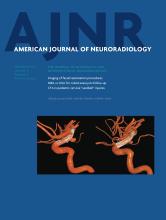Index by author
Dumont, D.
- BrainOpen AccessAn In Vivo, MRI-Integrated Real-Time Model of Active Contrast Extravasation in Acute Intracerebral HemorrhageR.I. Aviv, T. Huynh, Y. Huang, D. Ramsay, P. Van Slyke, D. Dumont, P. Asmah, R. Alkins, R. Liu and K. HynynenAmerican Journal of Neuroradiology September 2014, 35 (9) 1693-1699; DOI: https://doi.org/10.3174/ajnr.A3939
Dumont, T.M.
- InterventionalYou have accessEnhanced Aneurysmal Flow Diversion Using a Dynamic Push-Pull Technique: An Experimental and Modeling StudyD. Ma, J. Xiang, H. Choi, T.M. Dumont, S.K. Natarajan, A.H. Siddiqui and H. MengAmerican Journal of Neuroradiology September 2014, 35 (9) 1779-1785; DOI: https://doi.org/10.3174/ajnr.A3933
Ecker, O.
- InterventionalYou have accessIntracranial Aneurysmal Pulsatility as a New Individual Criterion for Rupture Risk Evaluation: Biomechanical and Numeric Approach (IRRAs Project)M. Sanchez, O. Ecker, D. Ambard, F. Jourdan, F. Nicoud, S. Mendez, J.-P. Lejeune, L. Thines, H. Dufour, H. Brunel, P. Machi, K. Lobotesis, A. Bonafe and V. CostalatAmerican Journal of Neuroradiology September 2014, 35 (9) 1765-1771; DOI: https://doi.org/10.3174/ajnr.A3949
Elefante, A.
- BrainYou have accessBrain Changes in Kallmann SyndromeR. Manara, A. Salvalaggio, A. Favaro, V. Palumbo, V. Citton, A. Elefante, A. Brunetti, F. Di Salle, G. Bonanni, A.A. Sinisi and for the Kallmann Syndrome Neuroradiological Study GroupAmerican Journal of Neuroradiology September 2014, 35 (9) 1700-1706; DOI: https://doi.org/10.3174/ajnr.A3946
Evans, A.J.
- Level 1 EBM Expedited PublicationOpen AccessPatients Prone to Recurrence after Endovascular Treatment: Periprocedural Results of the PRET Randomized Trial on Large and Recurrent AneurysmsJ. Raymond, R. Klink, M. Chagnon, S.L. Barnwell, A.J. Evans, J. Mocco, B.L. Hoh, A.S. Turk, R.D. Turner, H. Desal, D. Fiorella, S. Bracard, A. Weill, F. Guilbert and D. Roy on behalf of the PRET Collaborative GroupAmerican Journal of Neuroradiology September 2014, 35 (9) 1667-1676; DOI: https://doi.org/10.3174/ajnr.A4035
- InterventionalYou have accessPreoperative Embolization of Intracranial Meningiomas: Efficacy, Technical Considerations, and ComplicationsD.M.S. Raper, R.M. Starke, F. Henderson, D. Ding, S. Simon, A.J. Evans, J.A. Jane and K.C. LiuAmerican Journal of Neuroradiology September 2014, 35 (9) 1798-1804; DOI: https://doi.org/10.3174/ajnr.A3919
Favaro, A.
- BrainYou have accessBrain Changes in Kallmann SyndromeR. Manara, A. Salvalaggio, A. Favaro, V. Palumbo, V. Citton, A. Elefante, A. Brunetti, F. Di Salle, G. Bonanni, A.A. Sinisi and for the Kallmann Syndrome Neuroradiological Study GroupAmerican Journal of Neuroradiology September 2014, 35 (9) 1700-1706; DOI: https://doi.org/10.3174/ajnr.A3946
Fiorella, D.
- Level 1 EBM Expedited PublicationOpen AccessPatients Prone to Recurrence after Endovascular Treatment: Periprocedural Results of the PRET Randomized Trial on Large and Recurrent AneurysmsJ. Raymond, R. Klink, M. Chagnon, S.L. Barnwell, A.J. Evans, J. Mocco, B.L. Hoh, A.S. Turk, R.D. Turner, H. Desal, D. Fiorella, S. Bracard, A. Weill, F. Guilbert and D. Roy on behalf of the PRET Collaborative GroupAmerican Journal of Neuroradiology September 2014, 35 (9) 1667-1676; DOI: https://doi.org/10.3174/ajnr.A4035
Fugate, J.E.
- FELLOWS' JOURNAL CLUBBrainYou have accessEarly Basal Ganglia Hyperperfusion on CT Perfusion in Acute Ischemic Stroke: A Marker of Irreversible Damage?V. Shahi, J.E. Fugate, D.F. Kallmes and A.A. RabinsteinAmerican Journal of Neuroradiology September 2014, 35 (9) 1688-1692; DOI: https://doi.org/10.3174/ajnr.A3935
These authors found that increased cerebral blood flow and volume were seen in the basal ganglia of 4.3% of patients with ischemic strokes with CT perfusion. All patients had underlying MCA occlusions, 30% underwent hemorrhagic transformations, and the hyperperfused areas eventually became infarcted in all. Thus, acute basal ganglia hyperperfusion in patients with stroke may indicate nonviable parenchyma.
Garg, R.K.
- FELLOWS' JOURNAL CLUBBrainYou have accessNeuroimaging Features and Predictors of Outcome in Eclamptic Encephalopathy: A Prospective Observational StudyV. Junewar, R. Verma, P.L. Sankhwar, R.K. Garg, M.K. Singh, H.S. Malhotra, P.K. Sharma and A. PariharAmerican Journal of Neuroradiology September 2014, 35 (9) 1728-1734; DOI: https://doi.org/10.3174/ajnr.A3923
Imaging findings in 45 patients with eclampticposterior reversible encephalopathy syndrome were assessed. The most common affected areas were the occipital, parietal, frontal, and temporal lobes. Serum creatinine, uric acid, and lactate dehydrogenase values and presence of moderate or severe PRES were significantly associated with mortality. Eclamptic PRES demonstrated a higher incidence of atypical distributions and cytotoxic edema than previously thought.
Garrido, C.
- FELLOWS' JOURNAL CLUBHead & NeckYou have accessUse of Non-Echo-Planar Diffusion-Weighted MR Imaging for the Detection of Cholesteatomas in High-Risk Tympanic Retraction PocketsA. Alvo, C. Garrido, Á. Salas, G. Miranda, C.E. Stott and P.H. DelanoAmerican Journal of Neuroradiology September 2014, 35 (9) 1820-1824; DOI: https://doi.org/10.3174/ajnr.A3952
HASTE DWI was used to examine 16 patients before cholesteatoma surgery and the findings were compared with those seen intraoperatively. HASTE DWI showed 90% sensitivity, 100% specificity, 100% positive predictive value, and 85.7% negative predictive value in this group of patients. Only 1 false-negative finding in an infected cholesteatoma occurred.








